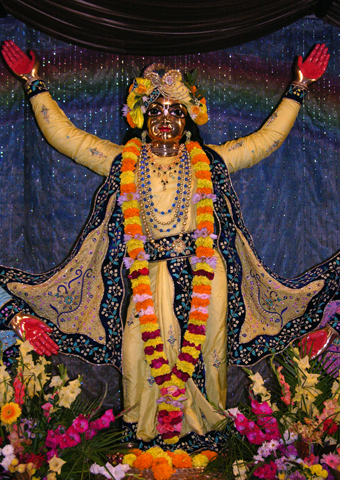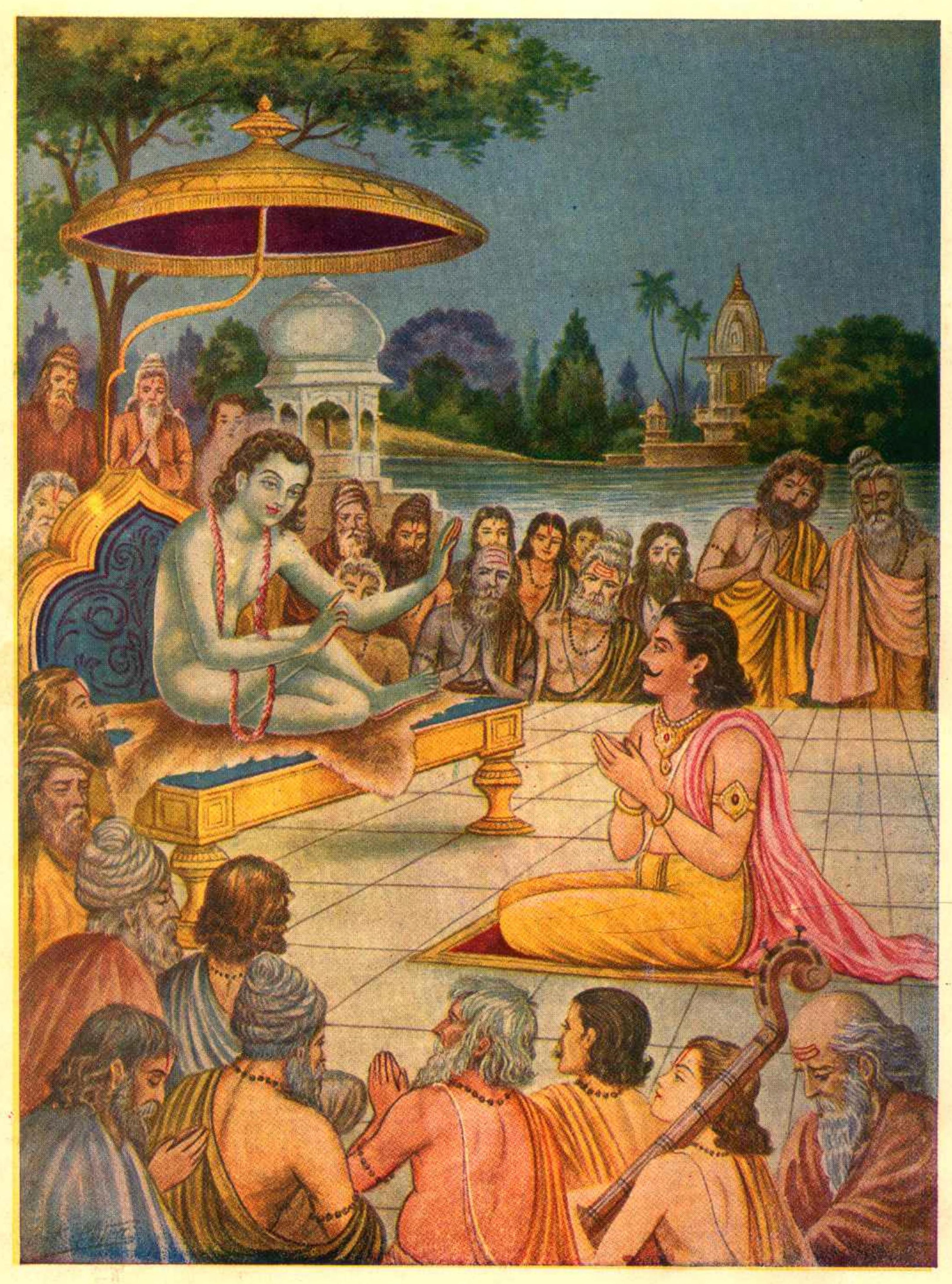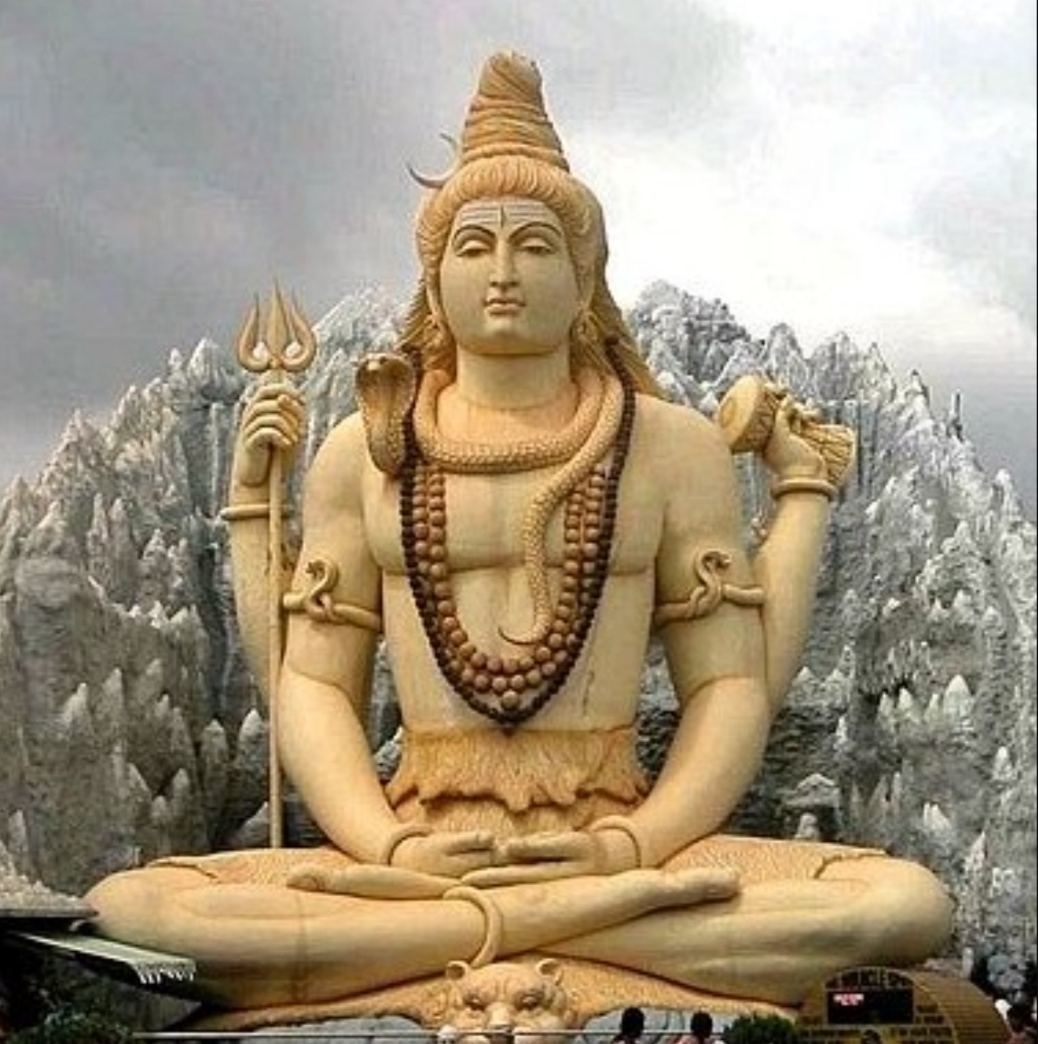|
Gaudiya
Gaudiya Vaishnavism (), also known as Chaitanya Vaishnavism, is a Vaishnava Hindu religious movement inspired by Chaitanya Mahaprabhu (1486â1534) in India. "Gaudiya" refers to the Gaura or Gauá¸a region of Bengal (present-day Malda district of West Bengal and Rajshahi district of Bangladesh), with Vaishnavism meaning "the worship of Vishnu". Specifically, it is part of KrishnaismâKrishna-centric Vaishnavite traditions. Its theological basis is primarily that of the ''Bhagavad Gita'' and ''Bhagavata Purana'' (known within the tradition as the ''Srimad Bhagavatam''), as interpreted by early followers of Chaitanya, such as Sanatana Goswami, Rupa Goswami, Jiva Goswami, Gopala Bhatta Goswami and others. The focus of Gaudiya Vaishnavism is the devotional worship (known as bhakti yoga) of Radha and Krishna, and their many divine incarnations as the supreme forms of God, '' Svayam Bhagavan''. Most popularly, this worship takes the form of singing Radha and Krishna's holy na ... [...More Info...] [...Related Items...] OR: [Wikipedia] [Google] [Baidu] |
Vaishnavism
Vaishnavism () ), also called Vishnuism, is one of the major Hindu denominations, Hindu traditions, that considers Vishnu as the sole Para Brahman, supreme being leading all other Hindu deities, that is, ''Mahavishnu''. It is one of the major Hindu denominations along with Shaivism, Shaktism, and Smartism. Its followers are called Vaishnavites or ''Vaishnava''s (), and it includes sub-sects like Krishnaism and Ramanandi Sampradaya, Ramaism, which consider Krishna and Rama as the supreme beings respectively. According to a 2020 estimate by The World Religion Database (WRD), hosted at Boston Universityâs Institute on Culture, Religion and World Affairs (CURA), Vaishnavism is the largest Hindu sect, constituting about 399 million Hindus. The ancient emergence of Vaishnavism is unclear, and broadly hypothesized as a History of Hinduism, fusion of various regional non-Vedic religions with worship of Vishnu. It is considered a merger of several popular non-Vedic theistic traditio ... [...More Info...] [...Related Items...] OR: [Wikipedia] [Google] [Baidu] |
Jiva Goswami
Jiva Goswami (; ) was an Indian philosopher and saint from the Gaudiya Vaishnava school of Vedanta tradition, producing a great number of philosophical works on the theology and practice of Bhakti yoga, Vaishnava Vedanta and associated disciplines. He is known as one of the Six Goswamis of Vrindavan and was the nephew of the two leading figures, Rupa Goswami and Sanatana Goswami. Biography Genealogy His family lineage can be traced to Indian State of Karnataka and Naihati in the district of North 24 Parganas in present-day West Bengal, India. The former generations according to ''Bhakti-ratnakara'': Sarvajna Jagatguru was a famous Brahmin, brahmana, great scholar in all Vedas, respected Yajurveda, Yajur-vedi of the Baradvaja caste, and king of Karnataka in South India, adored by all other contemporary kings. Sarvajna's son, Aniruddha, was spirited, famous, a proficient scholar of the Vedas, and a favourite of the reigning kings at the time. Aniruddha's sons, Rupesvara (eldes ... [...More Info...] [...Related Items...] OR: [Wikipedia] [Google] [Baidu] |
Krishnaism
Krishnaism is a term used in scholarly circles to describe large group of independent Hinduism, Hindu traditionsâsampradayas related to Vaishnavismâthat center on the devotion to Krishna as ''Svayam Bhagavan'', ''Ishvara'', ''Para Brahman'', who is the source of all reality, not simply an avatar of Vishnu. This is its difference from such Vaishnavite groupings as Sri Vaishnavism, Sadh Vaishnavism, Ramanandi, Ramaism, Radha Vallabh Sampradaya, Radhaism, Sitaism etc. There is also a personal Krishnaism, that is devotion to Krishna outside of any tradition and community, as in the case of the saint-poet Meera Bai. Leading scholars do not define Krishnaism as a suborder or offshoot of Vaishnavism, considering it at least a parallel and no less ancient current of Hinduism. The teachings of the ''Bhagavad Gita'' can be considered as the first Krishnaite system of theology. Krishnaism originated in the late centuries BCE from the followers of the heroic VÄsudeva Krishna, which a ... [...More Info...] [...Related Items...] OR: [Wikipedia] [Google] [Baidu] |
Rupa Goswami
Rupa Goswami Rupa Goswami (, , ; 1489â1564) was a devotional teacher (guru), poet, and philosopher of the Gaudiya Vaishnava tradition. With his brother Sanatana Goswami, he is considered the most senior of the Six Goswamis of Vrindavan associated with Chaitanya Mahaprabhu, a avatar (incarnation) of Krishna in Kali Yuga. Biography Genealogy His family lineage can be traced to Indian State of Karnataka and Naihati in the district of North 24 Parganas in present-day West Bengal, India. The former generations according to ''Bhakti-ratnakara'': Sarvajna Jagatguru was a famous brahmana, scholar in all Vedas, respected Yajur-vedi of the Baradvaja caste, and king of Karnataka in South India, adored by all other contemporary kings. Sarvajna's son, Aniruddha, was spirited, proficient scholar of the Vedas and a favorite of the reigning kings at the time. Aniruddha's sons, Rupesvara (eldest) and Harihara, were respected due to their virtuous qualities. Rupesvara was known as a ... [...More Info...] [...Related Items...] OR: [Wikipedia] [Google] [Baidu] |
Chaitanya Mahaprabhu
Chaitanya Mahaprabhu (; ), born Vishvambhara Mishra () (18 February 1486 â 14 June 1534), was an Indian Hindus, Hindu saint from Bengal and the founder of Gaudiya Vaishnavism. Chaitanya Mahaprabhu's mode of worshipping Krishna with bhajan-kirtan and dance had a profound effect on Vaishnavism in Bengal. He is considered the chief proponent of the Vedantic philosophy of Achintya Bheda Abheda. However, the concept of inconceivable difference in non-difference, known as achintya-bhedabheda, was developed later by Jiva Gosvami in his book Bhagavat Sandharbha. Mahaprabhu founded Gaudiya Vaishnavism. He expounded Bhakti yoga and popularised the chanting of the Hare Krishna (mantra), Hare Krishna Maha-mantra. He composed the ''Shikshashtakam'' (eight devotional prayers). Chaitanya is sometimes called Gauranga () or Gaura due to his molten goldâlike complexion. His birthday is celebrated as Gaura-purnima. He is also called Nimai because he was born underneath a Neem tree. ... [...More Info...] [...Related Items...] OR: [Wikipedia] [Google] [Baidu] |
Bhagavata Purana
The ''Bhagavata Purana'' (; ), also known as the ''Srimad Bhagavatam (ÅrÄ«mad BhÄgavatam)'', ''Srimad Bhagavata Mahapurana'' () or simply ''Bhagavata (BhÄgavata)'', is one of Hinduism's eighteen major Puranas (''Mahapuranas'') and one of the most popular in Vaishnavism. Composed in Sanskrit and traditionally attributed to Veda Vyasa, it promotes '' bhakti'' (devotion) towards Krishna, an avatar of Vishnu, integrating themes from the Advaita (monism) philosophy of Adi Shankara, the Vishishtadvaita (qualified monism) of Ramanujacharya and the Dvaita (dualism) of Madhvacharya. It is widely available in almost all Indian languages. The ''Bhagavata Purana'', like other puranas, discusses a wide range of topics including cosmology, astronomy, genealogy, geography, legend, music, dance, yoga and culture. As it begins, the forces of evil have won a war between the benevolent '' devas'' (deities) and evil '' asuras'' (demons) and now rule the universe. Truth re-emerges as ... [...More Info...] [...Related Items...] OR: [Wikipedia] [Google] [Baidu] |
Sanatana Goswami
Sanatana Goswami (, ; ; 1488â1558) was a principal follower of Chaitanya Mahaprabhu. Sanatana wrote a number of works in the bhakti tradition of Gaudiya Vaishnavism and was the senior most of the influential Six Goswamis of Vrindavan, among whom was his brother Rupa Goswami. Biography Genealogy His family lineage can be traced to Indian State of Karnataka and Naihati in the district of North 24 Parganas in present-day West Bengal, India. The former generations according to ''Bhakti-ratnakara'': Sarvajna Jagatguru was a known brahmana, scholar in all Vedas, respected Yajur-vedi of the Baradvaja caste, and king of Karnataka in South India, adored by all other contemporary kings. Sarvajna's son, Aniruddha, was spirited, famous, a proficient scholar of the Vedas, and a favorite of the reigning kings at the time. Aniruddha's sons, Rupesvara (eldest) and Harihara, were respected due to their virtuous qualities. Rupesvara was known as a scholar of the scriptures, while Harihara ... [...More Info...] [...Related Items...] OR: [Wikipedia] [Google] [Baidu] |
Krishna
Krishna (; Sanskrit language, Sanskrit: à¤à¥à¤·à¥à¤£, ) is a major deity in Hinduism. He is worshipped as the eighth avatar of Vishnu and also as the Supreme God (Hinduism), Supreme God in his own right. He is the god of protection, compassion, tenderness, and love; and is widely revered among Hindu divinities. Krishna's birthday is celebrated every year by Hindus on Krishna Janmashtami according to the lunisolar calendar, lunisolar Hindu calendar, which falls in late August or early September of the Gregorian calendar. The anecdotes and narratives of Krishna's life are generally titled as ''Krishna LÄ«lÄ''. He is a central figure in the ''Mahabharata'', the ''Bhagavata Purana'', the ''Brahma Vaivarta Purana,'' and the ''Bhagavad Gita'', and is mentioned in many Hindu philosophy, Hindu philosophical, Hindu theology, theological, and Hindu mythology, mythological texts. They portray him in various perspectives: as a god-child, a prankster, a model lover, a divine hero, ... [...More Info...] [...Related Items...] OR: [Wikipedia] [Google] [Baidu] |
Nityananda
Nityananda (, ; c. 1474-c. 1540), also called Nityananda Prabhu and Nitai, was a primary religious figure within the Gaudiya Vaishnava tradition of Bengal. Nityananda was Chaitanya Mahaprabhu's friend and disciple. Chaitanya and Nityananda are often mentioned together as ''Gaura-Nitai'' (''Gaura'', referring to Chaitanya) or ''Nimai-Nitai'' (''Nimai'' being a name of Chaitanya). According to Gaudiya-Vaishnava tradition, Nityananda is Balarama Himself (so is also called Nityananda Rama, where ''Rama'' refers to Balarama), with Chaitanya being His eternal brother and friend, Krishna. Chaitanya is considered the "most merciful" incarnation of Krishna as ''Svayam bhagavan''. Bhaktisiddhanta Sarasvati, the early 20th-century Gaudiya-Vaishnava reformer, writes about Nityananda's theological position as the embodiment of the mercy of the guru: "Nityananda is the Primary Manifestive Constituent of the Divinity. Nityananda alone possesses the distinctive function of the guru. In Nitya ... [...More Info...] [...Related Items...] OR: [Wikipedia] [Google] [Baidu] |
Gopala Bhatta Goswami
Gopala Bhatta Goswami (1503â1578) is one of the foremost disciples of the Vaishnava saint, Chaitanya Mahaprabhu, and a historical figure in the Gaudiya Vaishnava school of Hinduism. He was part of a group of Vaishnava devotees known collectively as the Six Goswamis of Vrindavan, who were influential in establishing the philosophical basis of the Gaudiya tradition in formalised writings. Background Born in a Sri Vaishnava family from the Tamil Iyengar community of Sriangam, and the son of Venkatta Bhatta, Gopala Bhatta Goswami was a devotee of Lakshmi Narayana. According to biographies such as the ''Bhakti Ratnakara,'' Gopala Bhatta's first meeting with Chaitanya Mahaprabhu was in 1510, during Mahaprabhu's tour of South India. Although he was a youth, he was given the opportunity to meet with Chaitanya and serve him for serveral months. Such was his love for the saint that when Chaitanya Mahaprabhu was about to leave, Gopala Bhatta became upset, and for Gopala Bhatta's s ... [...More Info...] [...Related Items...] OR: [Wikipedia] [Google] [Baidu] |
Vaishnava-Sahajiya
Vaiá¹£á¹ava SahajiyÄ was a form of Hindu tantric Vaishnavism focused on Radha Krishna worship that developed in Eastern India (Bengal, Bihar, Orissa, Assam).Hayes, Glen A"The Vaisnava Sahajiya Traditions of Medieval Bengal" in ''Religions of India in Practice'', edited by Donald S. Lopez, Jr., Princeton Readings in Religions, Princeton: Princeton University Press, 1995: 333-351. This tradition flourished from the 16th to the 19th century. The Vaiá¹£á¹ava SahajiyÄ tradition produced many great poets who wrote in the Bengali language, the most famous of these poets all wrote under the pen name Chandidas (a name used by various authors).Young, Mary (2014). ''The Baul Tradition: Sahaj Vision East and West,'' pp. 27-36. SCB Distributors. Their religious literature was mainly written in Bengali vernacular. Vaiá¹£á¹ava SahajiyÄ used the romance between Krishna and Radha as a metaphor for union with the innate or primordial condition (the Sahaja) present in everyone. They sough ... [...More Info...] [...Related Items...] OR: [Wikipedia] [Google] [Baidu] |
Hindu Denominations
Hindu denominations, ''sampradayas'', traditions, movements, and sects are traditions and sub-traditions within Hinduism centered on one or more gods or goddesses, such as Vishnu, Shiva, Shakti and so on. The term ''sampradaya'' is used for branches with a particular founder-guru with a particular philosophy. Hinduism has no central doctrinal authority and many practising Hindus do not claim to belong to any particular denomination or tradition. Four major traditions are, however, used in scholarly studies: ''Vaishnavism'', ''Shaivism'', ''Shaktism'' and ''Smartism''.Lance Nelson (2007), An Introductory Dictionary of Theology and Religious Studies (Editors: Orlando O. EspÃn, James B. Nickoloff), Liturgical Press, , pages 562â563 These are sometimes referred to as the denominations of Hinduism, and they differ in the primary deity at the centre of each tradition.SS Kumar (2010), Bhakti â the Yoga of Love, LIT Verlag Münster, , pp. 35â36. A notable feature of Hindu denom ... [...More Info...] [...Related Items...] OR: [Wikipedia] [Google] [Baidu] |








